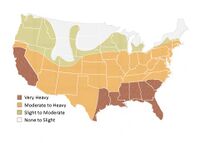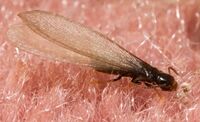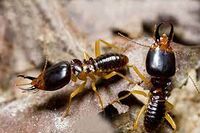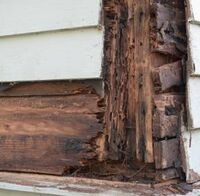Termites: Difference between revisions
m Spelling |
References |
||
| Line 1: | Line 1: | ||
==Overview== | ==Overview== | ||
[[File:TermiteNest.jpg|200px|thumb|right|Figure 1: Termite mound in Australia | [[File:TermiteNest.jpg|200px|thumb|right|Figure 1: Termite mound in Australia<ref name="Carter">Carter, Gareth. “Image Taken during Fieldwork to Pilbara Region in WA.” Australian Museum, 12 Aug. 2020, australian.museum/learn/animals/insects/termites/.</ref>]] | ||
Termites are [[insects]] belonging to the order Isoptera. There are more than 2,000 species of termites, which are divided into three main categories. | Termites are [[insects]] belonging to the order Isoptera. There are more than 2,000 species of termites, which are divided into three main categories<ref name= "Krishna">Krishna, Kumar. “Termite.” Encyclopædia Britannica, Encyclopædia Britannica, Inc., 8 Apr. 2020, www.britannica.com/animal/termite.</ref>. These categories are subterranean, drywood, and dampwood<ref name="Orkin1">Orkin. “Types of Termites - Different Kinds of Termite Species.” Orkin Termite Treatment, Pest Control & Exterminator Service, Orkin, 23 Mar. 2022, www.orkin.com/pests/termites/types-of-termites.</ref>. Termites live together in colonies, taking on different roles in the system to create harmony and order<ref name="Layton">Layton, Blake. “Termite Biology (Eastern Subterranean Termites and Formosan Termites).” Mississippi State University Extension Service, Mississippi State University, 4 Mar. 2017, extension.msstate.edu/content/termite-biology-eastern-subterranean-termites-and-formosan-termites#:~:text=Termite%20colonies%20contain%20three%20types,percent%20of%20the | ||
%20colony%20members.</ref>. | |||
{| class="wikitable" | {| class="wikitable" | ||
| Line 20: | Line 21: | ||
==Habitat== | ==Habitat== | ||
[[File:TermiteMapRevisedPNNL.jpeg|200px|thumb|right|Figure 2: Termite infestation probability map of the continental United States | [[File:TermiteMapRevisedPNNL.jpeg|200px|thumb|right|Figure 2: Termite infestation probability map of the continental United States<ref name="EERE">EERE. “Ermite Infestation Probability Map, Adapted from the 2021 International Residential Code (IRC), Figure R301.2(7).” Office of Energy Efficiency and Renewable Energy, U.S. Department of Energy, 2 Sept. 2021, basc.pnnl.gov/images/termite-infestation-probability-map-adapted-2021-international-residential-code-irc-figure.</ref>]] | ||
Termites are found all over the world, with species existing in every continent except Antarctica. | Termites are found all over the world, with species existing in every continent except Antarctica<ref name="Simon">Simon, Dany, and Gilad Ben-Zvi. “The Formosan Termite.” The Steinhardt Museum of Natural History, 25 Nov. 2021, smnh.tau.ac.il/en/the-formosan-termite/.</ref>. Termites do best in warm climates, so they are most often found in the tropics<ref name="Wildlife">“Termites.” National Wildlife Federation, 24 Oct. 2017, www.nwf.org/Educational-Resources/Wildlife-Guide/Invertebrates/Termites.</ref>. Subterranean termites are found underground, as they must maintain contact with [[soil]] to get moisture. Because of this, subterranean termites may be more destructive if they are found in a home. This is due to reproducing in large amounts underground, allowing for them to go undetected as damage is occurring. Drywood termites and dampwood termites are both found above ground. Drywood termites can be found in wood that is either living or decayed since they do not require a moisture source. Dampwood termites do not need contact with soil, but they do require a moisture source. Because of this, they are found in decayed wood that has consistent access to water<ref name= "Orkin1"></ref>. | ||
==Diet and Feeding Habits== | ==Diet and Feeding Habits== | ||
Termites feed mainly on cellulose, the main component of wood. | Termites feed mainly on cellulose, the main component of wood<ref name="Krishna2">Krishna, Kumar. “Nutrition.” Encyclopædia Britannica, Encyclopædia Britannica, Inc., 31 Jan. 2001, www.britannica.com/animal/termite/Nutrition.</ref>. Termites will also consume plant litter and soil [[humus]]. They will eat almost all cellulose material, including carpet, insulation, cardboard, etc<ref name="Orkin4">Orkin. “What do Termites Eat - Termite Diet and Feeding Habits.” Orkin Termite Treatment, Pest Control & Exterminator Service, Orkin, 23 Mar. 2022, www.orkin.com/pests/termites/what-do-termites-eat.</ref>. In order to digest their food, termites have bacteria and [[protozoa]] in their stomachs that produce enzymes to help break down cellulose<ref name="Wildlife"></ref>. Only workers feed directly; reproductives and soldiers must be fed by workers since they do not have these enzymes. The process of transferring food from workers to the rest of the colony happens mostly through the mouth, with workers regurgitating cellulose into the mouths of other termites<ref name="Orkin3">Orkin. “What Do Termites Eat: Termite Diet and Feeding Habits.” Orkin, Orkin, 29 Mar. 2022, www.orkin.com/pests/termites/what-do-termites-eat.</ref>. | ||
==Colony Roles== | ==Colony Roles== | ||
Termites fall into one of three roles in the colony: reproductives, workers, or soldiers. Each role has different characteristics that help keep the colony thriving. | Termites fall into one of three roles in the colony: reproductives, workers, or soldiers. Each role has different characteristics that help keep the colony thriving. | ||
[[File:QueenTermite.jpg|200px|thumb|left|Figure 3: Reproductive termite | [[File:QueenTermite.jpg|200px|thumb|left|Figure 3: Reproductive termite<ref name="Payne">Payne Pest Management. “Flying Termites FAQ's.” Payne Pest Management, 31 Aug. 2021, paynepestmgmt.com/flying-termites-faqs/.</ref>]] | ||
*'''Reproductives:''' It is the job of the reproductive termites to mate and keep the colony growing. The main reproductives in a colony are the queen and king. However, there may be other reproductives if the colony is large enough. | *'''Reproductives:''' It is the job of the reproductive termites to mate and keep the colony growing. The main reproductives in a colony are the queen and king. However, there may be other reproductives if the colony is large enough<ref name="Layton"></ref>. The queen and king have wings that allow them to leave their respective colonies and mate to form a new colony. Termites reproduce by laying eggs, and a queen can lay thousands of eggs each year<ref name="Waldvogel">Waldvogel, Michael, and Patricia Alder. “Termites - Biology and Control: NC State Extension Publications.” Termites - Biology and Control | NC State Extension Publications, NC State Extension Publications, 7 Apr. 2022, content.ces.ncsu.edu/termites-biology-and-control.</ref>. Queens have a long lifespan and can survive for decades, but most commonly live between 10 and 20 years<ref name="Terminix1">Terminix. “Termite Life Cycle and Lifespan.” Terminix, Https://Www.terminix.com/, 6 May 2022, www.terminix.com/termites/life-cycle/.</ref>. | ||
*'''Workers:''' Workers make up the vast majority of termites in the colony. | *'''Workers:''' Workers make up the vast majority of termites in the colony<ref name="Layton"></ref>. It is their job to gather food for the colony, build the nest, repair the nest after damage, and care for the queen<ref name="Waldvogel"></ref>. Worker and soldier termites do not have wings or reproductive organs<ref name= "Krishna"></ref>. Their life span is much shorter than that of the reproductives, lasting only 2 years on average<ref name="Orkin2">Orkin. “Termite Life Cycle & Lifespan - How Long Do Termites Live?” Orkin Termite Treatment, Pest Control & Exterminator Service, Orkin, 23 Mar. 2022, www.orkin.com/pests/termites/life-cycle.</ref>. | ||
[[File:SoldierTermites.jpeg|200px|thumb|right|Figure 4: Soldier termites | [[File:SoldierTermites.jpeg|200px|thumb|right|Figure 4: Soldier termites<ref name="Terminix2">Terminix. “Getting to Know Soldier Termites.” Terminix, 25 Mar. 2015, www.terminix.com/termite-control/infestation/getting-to-know-soldier-termites/.</ref>]] | ||
*'''Soldiers:''' Soldier termites protect the colony from predators, most notably ants. Soldiers possess large mandibles to aid them in defense. | *'''Soldiers:''' Soldier termites protect the colony from predators, most notably ants. Soldiers possess large mandibles to aid them in defense<ref name="Layton"></ref>. The lifespan of soldier termites is comparable to workers, lasting approximately 2 years<ref name="Orkin2"></ref>. | ||
==Termite Damage== | ==Termite Damage== | ||
[[File:TermiteDamage.jpeg|200px|thumb|right|Figure 5: Exterior of house with termite damage | [[File:TermiteDamage.jpeg|200px|thumb|right|Figure 5: Exterior of house with termite damage<ref name="Moore">Moore Law Firm. “Termite Lawyer, Termite Lawsuit In Mobile, AL.” Moore Law Firm, 22 May 2020, www.moorelawfirm-al.com/termite-lawyer/.</ref>]] | ||
Termites are a prevalent pest in the United States, and can easily make their way into houses through cracks, water buildup, or rotting wood. | Termites are a prevalent pest in the United States, and can easily make their way into houses through cracks, water buildup, or rotting wood<ref name="Dehan">Dehan, Andrew. “Termite Damage: How to Identify and Repair It.” Rocket Homes, Rocket Homes, 2 Mar. 2022, www.rockethomes.com/blog/homeowner-tips/termite-damage.</ref>. Damage is often done to homes as a result of termite infestation, and can be costly to repair if not caught right away. Termites chew through both softwood and hardwood, causing structural damage and even foundation problems<ref name="Griffin">Griffin Pest Solutions. “What Does Termite Damage Look like?” Griffin Pest Solutions, Griffin Pest Solutions, 2 May 2022, www.griffinpest.com/what-termite-damage-looks-like/.</ref>. Some signs of termite damage to look for include: | ||
*Hollowed out wood | *Hollowed out wood | ||
*Maze of tunnels in wood | *Maze of tunnels in wood | ||
| Line 47: | Line 48: | ||
*Cracked or peeling paint | *Cracked or peeling paint | ||
== | ==References== | ||
<references /> | |||
Revision as of 23:40, 13 March 2025
Overview

Termites are insects belonging to the order Isoptera. There are more than 2,000 species of termites, which are divided into three main categories[2]. These categories are subterranean, drywood, and dampwood[3]. Termites live together in colonies, taking on different roles in the system to create harmony and order[4].
| Scientific Classification | |
|---|---|
| Kingdom | Animalia |
| Phylum | Arthropoda |
| Class | Insecta |
| Order | Isoptera |
Habitat

Termites are found all over the world, with species existing in every continent except Antarctica[6]. Termites do best in warm climates, so they are most often found in the tropics[7]. Subterranean termites are found underground, as they must maintain contact with soil to get moisture. Because of this, subterranean termites may be more destructive if they are found in a home. This is due to reproducing in large amounts underground, allowing for them to go undetected as damage is occurring. Drywood termites and dampwood termites are both found above ground. Drywood termites can be found in wood that is either living or decayed since they do not require a moisture source. Dampwood termites do not need contact with soil, but they do require a moisture source. Because of this, they are found in decayed wood that has consistent access to water[3].
Diet and Feeding Habits
Termites feed mainly on cellulose, the main component of wood[8]. Termites will also consume plant litter and soil humus. They will eat almost all cellulose material, including carpet, insulation, cardboard, etc[9]. In order to digest their food, termites have bacteria and protozoa in their stomachs that produce enzymes to help break down cellulose[7]. Only workers feed directly; reproductives and soldiers must be fed by workers since they do not have these enzymes. The process of transferring food from workers to the rest of the colony happens mostly through the mouth, with workers regurgitating cellulose into the mouths of other termites[10].
Colony Roles
Termites fall into one of three roles in the colony: reproductives, workers, or soldiers. Each role has different characteristics that help keep the colony thriving.

- Reproductives: It is the job of the reproductive termites to mate and keep the colony growing. The main reproductives in a colony are the queen and king. However, there may be other reproductives if the colony is large enough[4]. The queen and king have wings that allow them to leave their respective colonies and mate to form a new colony. Termites reproduce by laying eggs, and a queen can lay thousands of eggs each year[12]. Queens have a long lifespan and can survive for decades, but most commonly live between 10 and 20 years[13].
- Workers: Workers make up the vast majority of termites in the colony[4]. It is their job to gather food for the colony, build the nest, repair the nest after damage, and care for the queen[12]. Worker and soldier termites do not have wings or reproductive organs[2]. Their life span is much shorter than that of the reproductives, lasting only 2 years on average[14].

- Soldiers: Soldier termites protect the colony from predators, most notably ants. Soldiers possess large mandibles to aid them in defense[4]. The lifespan of soldier termites is comparable to workers, lasting approximately 2 years[14].
Termite Damage

Termites are a prevalent pest in the United States, and can easily make their way into houses through cracks, water buildup, or rotting wood[17]. Damage is often done to homes as a result of termite infestation, and can be costly to repair if not caught right away. Termites chew through both softwood and hardwood, causing structural damage and even foundation problems[18]. Some signs of termite damage to look for include:
- Hollowed out wood
- Maze of tunnels in wood
- Wood bending or buckling
- Mud tubes
- Termite remnants (i.e., wings, waste, etc.)
- Cracked or peeling paint
References
- ↑ Carter, Gareth. “Image Taken during Fieldwork to Pilbara Region in WA.” Australian Museum, 12 Aug. 2020, australian.museum/learn/animals/insects/termites/.
- ↑ 2.0 2.1 Krishna, Kumar. “Termite.” Encyclopædia Britannica, Encyclopædia Britannica, Inc., 8 Apr. 2020, www.britannica.com/animal/termite.
- ↑ 3.0 3.1 Orkin. “Types of Termites - Different Kinds of Termite Species.” Orkin Termite Treatment, Pest Control & Exterminator Service, Orkin, 23 Mar. 2022, www.orkin.com/pests/termites/types-of-termites.
- ↑ 4.0 4.1 4.2 4.3 Layton, Blake. “Termite Biology (Eastern Subterranean Termites and Formosan Termites).” Mississippi State University Extension Service, Mississippi State University, 4 Mar. 2017, extension.msstate.edu/content/termite-biology-eastern-subterranean-termites-and-formosan-termites#:~:text=Termite%20colonies%20contain%20three%20types,percent%20of%20the %20colony%20members.
- ↑ EERE. “Ermite Infestation Probability Map, Adapted from the 2021 International Residential Code (IRC), Figure R301.2(7).” Office of Energy Efficiency and Renewable Energy, U.S. Department of Energy, 2 Sept. 2021, basc.pnnl.gov/images/termite-infestation-probability-map-adapted-2021-international-residential-code-irc-figure.
- ↑ Simon, Dany, and Gilad Ben-Zvi. “The Formosan Termite.” The Steinhardt Museum of Natural History, 25 Nov. 2021, smnh.tau.ac.il/en/the-formosan-termite/.
- ↑ 7.0 7.1 “Termites.” National Wildlife Federation, 24 Oct. 2017, www.nwf.org/Educational-Resources/Wildlife-Guide/Invertebrates/Termites.
- ↑ Krishna, Kumar. “Nutrition.” Encyclopædia Britannica, Encyclopædia Britannica, Inc., 31 Jan. 2001, www.britannica.com/animal/termite/Nutrition.
- ↑ Orkin. “What do Termites Eat - Termite Diet and Feeding Habits.” Orkin Termite Treatment, Pest Control & Exterminator Service, Orkin, 23 Mar. 2022, www.orkin.com/pests/termites/what-do-termites-eat.
- ↑ Orkin. “What Do Termites Eat: Termite Diet and Feeding Habits.” Orkin, Orkin, 29 Mar. 2022, www.orkin.com/pests/termites/what-do-termites-eat.
- ↑ Payne Pest Management. “Flying Termites FAQ's.” Payne Pest Management, 31 Aug. 2021, paynepestmgmt.com/flying-termites-faqs/.
- ↑ 12.0 12.1 Waldvogel, Michael, and Patricia Alder. “Termites - Biology and Control: NC State Extension Publications.” Termites - Biology and Control | NC State Extension Publications, NC State Extension Publications, 7 Apr. 2022, content.ces.ncsu.edu/termites-biology-and-control.
- ↑ Terminix. “Termite Life Cycle and Lifespan.” Terminix, Https://Www.terminix.com/, 6 May 2022, www.terminix.com/termites/life-cycle/.
- ↑ 14.0 14.1 Orkin. “Termite Life Cycle & Lifespan - How Long Do Termites Live?” Orkin Termite Treatment, Pest Control & Exterminator Service, Orkin, 23 Mar. 2022, www.orkin.com/pests/termites/life-cycle.
- ↑ Terminix. “Getting to Know Soldier Termites.” Terminix, 25 Mar. 2015, www.terminix.com/termite-control/infestation/getting-to-know-soldier-termites/.
- ↑ Moore Law Firm. “Termite Lawyer, Termite Lawsuit In Mobile, AL.” Moore Law Firm, 22 May 2020, www.moorelawfirm-al.com/termite-lawyer/.
- ↑ Dehan, Andrew. “Termite Damage: How to Identify and Repair It.” Rocket Homes, Rocket Homes, 2 Mar. 2022, www.rockethomes.com/blog/homeowner-tips/termite-damage.
- ↑ Griffin Pest Solutions. “What Does Termite Damage Look like?” Griffin Pest Solutions, Griffin Pest Solutions, 2 May 2022, www.griffinpest.com/what-termite-damage-looks-like/.